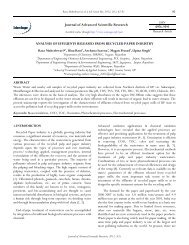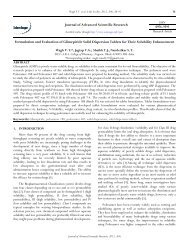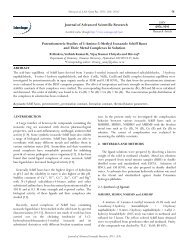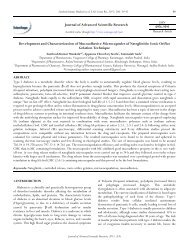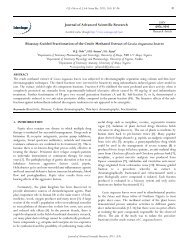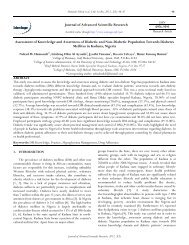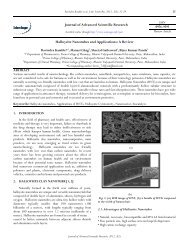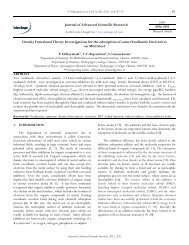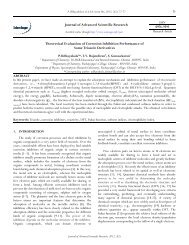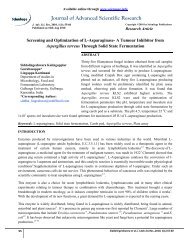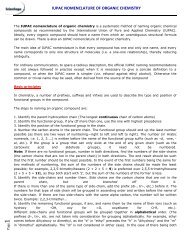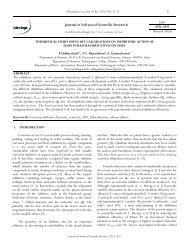Insecticidal activity of plant extracts against ... - Sciensage.info
Insecticidal activity of plant extracts against ... - Sciensage.info
Insecticidal activity of plant extracts against ... - Sciensage.info
You also want an ePaper? Increase the reach of your titles
YUMPU automatically turns print PDFs into web optimized ePapers that Google loves.
M. Mostafa et al, J Adv Sci Res, 2012, 3(3): 80-84 80<br />
Journal <strong>of</strong> Advanced Scientific Research<br />
Available online through http://www.sciensage.<strong>info</strong>/jasr<br />
ISSN<br />
0976-9595<br />
Research Article<br />
<strong>Insecticidal</strong> <strong>activity</strong> <strong>of</strong> <strong>plant</strong> <strong>extracts</strong> <strong>against</strong> Tribolium castaneum Herbst<br />
M. Mostafa * , Hemayet Hossain, M Anwar Hossain, Pizush Kanti Biswas, M. Zahurul Haque<br />
Chemical Research Division, BCSIR Laboratories, Dhaka- 1205, Bangladesh<br />
*Corresponding author: mostafabcsir@yahoo.com<br />
ABSTRACT<br />
The insecticidal <strong>activity</strong> <strong>of</strong> n-hexane, methanol and water <strong>extracts</strong> <strong>of</strong> Tamarindus indica, Azadirachta indica, Cucumis sativus, Eucalyptus<br />
species, Switenia mahagoni, and Psidium guajava leaves were investigated by using the Film residue method <strong>against</strong> a red flour beetle<br />
Tribolium castaneum Herbst. The results showed that four <strong>plant</strong> <strong>extracts</strong> showed a strong to moderate toxicity at a different<br />
concentration on red flour beetle. Among them, Cucumus sativus leaves extract showed highest mortality (80%) whereas Psidium<br />
guajava extract showed lowest mortality (50%). Among the solvents, the hexane <strong>extracts</strong> showed more toxic effect than other<br />
<strong>extracts</strong>. The LC50 results revealed that the hexane extract <strong>of</strong> Cucumus sativus is the most toxic to the pest followed by the hexane<br />
<strong>extracts</strong> <strong>of</strong> Azadirachta indica and Tamarindus indica. Qualitative phytochemical analysis has also been performed.<br />
Keywords: Azadirachta indica, Tamarindus indica, Cucumis sativus, Eucalyptus species, Switenia mahagoni, Psidium guajava, insecticidal<br />
<strong>activity</strong><br />
1. INTRODUCTION<br />
The protection <strong>of</strong> stored grain and seeds <strong>against</strong> insect<br />
pests has been a major problem from the development <strong>of</strong><br />
agriculture. Plant products have been successfully exploited as<br />
insecticides, insect repellents and insect antifeedants [1-3]<br />
Higher <strong>plant</strong>s are a rich source <strong>of</strong> novel natural substances that<br />
can be used to develop environmental safe methods for insect<br />
control [4]. <strong>Insecticidal</strong> <strong>activity</strong> <strong>of</strong> many <strong>plant</strong>s <strong>against</strong> several<br />
insect pests has been demonstrated [5-7]. The deleterious<br />
effects <strong>of</strong> <strong>plant</strong> <strong>extracts</strong> or pure compounds on insects can be<br />
manifested in several manners including toxicity, mortality,<br />
antifeedant growth inhibitor, suppression <strong>of</strong> reproductive<br />
behaviour and eduction <strong>of</strong> fecundity and fertility. Yang and<br />
Tang [8] reviewed the <strong>plant</strong>s used for pest insect control and<br />
found that there is a strong connection between medicinal and<br />
pesticidal <strong>plant</strong>s.<br />
To minimize use <strong>of</strong> synthetic pesticides and to avoid<br />
pollution <strong>of</strong> the environment, natural antifeedant, deterrent<br />
and repellent substances have been searched for pest control<br />
during recent times [9-11]. However, there is an urgent need<br />
to develop safe alternatives that are <strong>of</strong> low cost, convenient to<br />
use and environmentally friendly. Considerable efforts have<br />
been focused on <strong>plant</strong> derived materials, potentially useful as<br />
commercial insecticides. The aim <strong>of</strong> our study is to evaluate the<br />
insecticidal <strong>activity</strong> <strong>of</strong> the hexane, methanol and water <strong>extracts</strong><br />
<strong>of</strong> Tamarindus indica, Azadirachta indica, Cucumis sativusn, Lens<br />
culinaris, Eucalyptus species, Switenia mahagoni, and Psidium<br />
guajava leaves<br />
2. MATERIAL AND METHODS<br />
2.1. Plant materials<br />
The Tamarindus indica leaves (Tentul), Azadirachta indica<br />
leaves (Neem), Cucumis sativus leaves (Shasha) and Lens culinaris<br />
(Masur) were collected from the Norshindi district,<br />
Bangladesh. The Eucalyptus species (Eucalyptus) and Switenia<br />
mahagoni (Mahogoni) were collected from the BCSIR campus,<br />
Dhaka and the Psidium guajava leaves (Goam) was collected<br />
from the BCSIR Laboratories, Rajshahi campus. The leaves<br />
were dried under shade and finally dried in an oven at 45 0 C for<br />
48 hours before grinding. The dried <strong>plant</strong> materials were<br />
ground into powder with an electrical blender.<br />
2.2. Extraction <strong>of</strong> <strong>plant</strong> materials<br />
The <strong>plant</strong> powders (100 g each <strong>plant</strong> sample) were<br />
separately extracted in hexane, methanol and water for 24 h on<br />
an orbital shaker. The <strong>extracts</strong> were filtered using a Buchner<br />
funnel and Whatman no. 1 filter paper. The hexane, methanol<br />
<strong>extracts</strong> were evaporated to dryness under reduced pressure at<br />
40 0 C using a vacuum rotary evaporator, while the water<br />
extract was freeze-dried with Savant Refrigerated Vapor Trap.<br />
Each <strong>extracts</strong> were kept in freeze for further work in future.<br />
2.3. Insect bioassays<br />
2.3.1. Test Insects<br />
The red flour beetle, T. castaneum were collected from<br />
the stock cultures maintained in the BCSIR Laboratories,<br />
Rajshahi. Mass cultures were maintained in glass jars (1000ml)<br />
Journal <strong>of</strong> Advanced Scientific Research, 2012, 3(3)
and subcultures were in beakers (500ml) with food medium<br />
and kept in an incubator at 30±0.5°C. A standard mixture <strong>of</strong><br />
whole-wheat flour with powdered dry yeast in a ratio <strong>of</strong> 19:1<br />
[12, 13] was used as food medium throughout the<br />
experimental period.<br />
2.4. Mortality tests<br />
Film residue method [14] was used to test the mortality <strong>of</strong><br />
the adults <strong>of</strong> T. castaneum. The extracted materials were<br />
weighed and dissolved in acetone for dosing. For testing<br />
beetle, mortality four doses were used including control<br />
(water). Ten to fifteen day-old adults <strong>of</strong> T. castaneum was used<br />
at 372.95, 785.91 and 1571.83 μg/cm 2 concentrations. The<br />
doses were prepared by mixing the requisite quantities <strong>of</strong> the<br />
product with 1 ml acetone/ water. After mixing properly the<br />
liquid was dropped in a petri dish (9.5-cm diameter). After<br />
drying by fanning and finally in an oven at 40 ºC, 20 adults <strong>of</strong><br />
each species were released in each Petri dish. For each dose<br />
three replications were taken. The doses were calculated by<br />
measuring the weight <strong>of</strong> prepared product (μg) in 01 ml <strong>of</strong><br />
water divided by the surface area <strong>of</strong> the petri dish and it was<br />
converted into μg/cm 2 . Mortality was assessed after 24, 48 and<br />
72 h <strong>of</strong> the treatment. The calculation <strong>of</strong> mortality rate was<br />
corrected for control mortality according to Abbott’s formula<br />
[15]:<br />
Mc = (Mo Mc/100 Me) 100<br />
Where, Mo = Observed mortality rate <strong>of</strong> treated adults (%),<br />
Me = mortality rate <strong>of</strong> control (%), and Mc = corrected<br />
mortality rate (%)<br />
The LD 50 values were determined by probit analysis [14].<br />
The experiments were performed in the laboratory at 30ºC ±<br />
0.5ºC.<br />
2.5. Statistical analyses<br />
The experiment results were statistically analyzed by the<br />
mean <strong>of</strong> one-way analysis <strong>of</strong> variance ANOVA and when<br />
results were significant at p =0.5, Ducan test was used.<br />
2.6. Phytochemical screening<br />
Phytochemical screening <strong>of</strong> the <strong>extracts</strong> was carried out<br />
using the standard procedures described by Edeoga et al [16]<br />
for alkaloids, saponins, tannins, flavonoids, anthraquinones and<br />
steroids.<br />
3. RESULTS AND DISCUSSION<br />
The results <strong>of</strong> preliminary phytochemical analysis <strong>of</strong><br />
various <strong>extracts</strong> <strong>of</strong> Tamarindus indica, Azadirachta indica, Cucumis<br />
sativus, Eucalyptus species, Switenia mahagoni and Psidium guajava<br />
M. Mostafa et al, J Adv Sci Res, 2012, 3(3): 80-84 81<br />
are presented in Table 4. The hexane <strong>extracts</strong> <strong>of</strong> Azadirachta<br />
indica, Cucumis sativus and Tamarindus indica showed the<br />
presence <strong>of</strong> steroids and saponins. The methanol <strong>extracts</strong> <strong>of</strong><br />
Azadirachta indica, Eucalyptus species, Psidium guajava, Switenia<br />
mahagoni and Tamarindus indica showed the presence <strong>of</strong><br />
flavonoids, tannins and saponins, whereas the water <strong>extracts</strong> <strong>of</strong><br />
Azadirachta indica, Cucumis sativus, Psidium guajava, Switenia<br />
mahagoni and Tamarindus indica contained flavonoids and<br />
tannins.<br />
The toxic effects <strong>of</strong> hexane, methanol and water <strong>extracts</strong><br />
<strong>of</strong> Tamarindus indica, Azadirachta indica, Cucumis sativus,<br />
Eucalyptus species, Switenia mahagoni and Psidium guajava were<br />
evaluated <strong>against</strong> red flour beetle, T. castaneum by using the<br />
method <strong>of</strong> residual film technique. Six different <strong>extracts</strong> <strong>of</strong><br />
Tamarindus indica (TI-1), Azadirachta indica (AI-1 & AI-3),<br />
Cucumis sativus (CS-1 & CS-2) and Psidium guajava (PG-1) at<br />
different concentration revealed toxicity but any solvent<br />
<strong>extracts</strong> <strong>of</strong> two <strong>plant</strong>s, Eucalyptus species and Switenia mahagoni<br />
did not showed any toxic effect to red flour beetle. The<br />
numbers <strong>of</strong> dead red flour beetle were counted after 24, 48<br />
and 72 hours at all doses 198.48, 392.95, 785.91 and 1571.83<br />
μg/cm 2 respectively. Then the percentages <strong>of</strong> corrected<br />
mortality were calculated by using Abbott’s formula and the<br />
results are shown in Table-1. The results showed that the<br />
hexane extract <strong>of</strong> Cucumis sativus (CS-1) possessed the highest<br />
toxicity at all doses but the hexane <strong>extracts</strong> <strong>of</strong> Azadirachta indica<br />
(AI-1), Tamarindus indica (TI-1) and the methanol extract <strong>of</strong><br />
Cucumis sativus (CS-2) showed the moderate toxicity at<br />
concentrations 785.91 and 1571.83 μg/cm 2 , whereas the<br />
hexane extract <strong>of</strong> Psidium guajava leaf (PG-1) possessed the<br />
lowest (50%) toxic effect at highest concentration1571.83<br />
μg/cm 2 <strong>against</strong> red flour beetle, T. castaneum. The order <strong>of</strong><br />
toxicity <strong>of</strong> the six different <strong>plant</strong> <strong>extracts</strong> on red flour beetle,<br />
T. castaneum were: Cucumis sativus (CS-1) > Azadirachta indica<br />
(AI-1) > Cucumis sativus (CS-2) > Tamarindus indica (TI-1) ><br />
Azadirachta indica (AI-3) > Psidium guajava (PG-1). The<br />
mortality percentage was directly proportional to the level <strong>of</strong><br />
concentration <strong>of</strong> <strong>plant</strong> extract.<br />
The results <strong>of</strong> the probit analysis for the estimation <strong>of</strong> LC 50<br />
values, 95% confidence limits and regression equation at 24,<br />
48 and 72h for the mortality <strong>of</strong> red flour beetle are presented<br />
in Table 2. The LC 50 values <strong>of</strong> hexane <strong>extracts</strong> <strong>of</strong> Cucumis sativus<br />
(CS-1), Azadirachta indica (AI-1), Tamarindus indica (TI-1) and<br />
Psidium guajava (PG-1) at 24 hours after treatment are 20.64,<br />
234.57, 732.53 and 1944.40 μg/cm 2 , at 48 hours after<br />
treatment are 24.43, 91.80, 178.74 and 1944.40 μg/cm 2 and<br />
at 78 hours after treatment are 10.74, 155.13, 58.36 and<br />
774.22 μg/cm 2 respectively. The LC 50 values <strong>of</strong> methanol<br />
extract <strong>of</strong> Cucumis sativus (CS-2) at 24 hours after treatment is<br />
557.87 μg/cm 2 , at 48 hours after treatment is 153.32 μg/cm 2<br />
and at 78 hours after treatment is 20.64 μg/cm 2 respectively.<br />
Journal <strong>of</strong> Advanced Scientific Research, 2012, 3(3)
The LC 50 values <strong>of</strong> water extract <strong>of</strong> Azadirachta indica (AI-3) at<br />
24 hours after treatment is 990.26 μg/cm 2 , at 48 hours after<br />
treatment is 38.02 μg/cm 2 and at 78 hours after treatment is<br />
38.02 μg/cm 2 respectively. The results indicated that the<br />
hexane extract <strong>of</strong> Cucumis sativus (CS-1) at 72 hours after<br />
treatment was the most toxic (10.74µg/cm 2 ) and the hexane<br />
extract <strong>of</strong> Psidium guajava (PG-1) was the least toxic<br />
(1944µg/cm 2 ). The hexane extract <strong>of</strong> Cucumis sativus (CS-1)<br />
also maintained its toxicity, when the LC 50 values were<br />
compared at 24 HAT (20.64%) and 48 HAT (24.43%). The<br />
Chi-square values <strong>of</strong> different <strong>plant</strong> <strong>extracts</strong> at different HAT<br />
were insignificant at 5% level <strong>of</strong> probability and did not show<br />
any heterogeneity <strong>of</strong> the mortality data. The present study<br />
results are in conformity with the results <strong>of</strong> Mamun et al [17]<br />
M. Mostafa et al, J Adv Sci Res, 2012, 3(3): 80-84 82<br />
who reported that T. castaneum adults were significantly more<br />
susceptible to the toxicity <strong>of</strong> the hexane and water extract <strong>of</strong><br />
Azadirachta indica. Khalequzzaman and Sultana [18] also<br />
reported the toxic effect <strong>of</strong> petroleum ether extract <strong>of</strong> Annona<br />
squamosa seed on T. castaneum. The toxic and sterilizing effects<br />
<strong>of</strong> A. calamus rhizome oil to certain stored grain insects have<br />
also been reported by Saxena and Mathur [19]. The secondary<br />
metabolites <strong>of</strong> <strong>plant</strong>s are vast repository <strong>of</strong> compounds with<br />
wide range <strong>of</strong> biological <strong>activity</strong>. It has been reported that the<br />
steroids, phenolic compounds and tannins had great impact on<br />
insecticidal acitivities. The different <strong>plant</strong>s <strong>extracts</strong> in our<br />
present study revealed the toxicity <strong>against</strong> store insect may be<br />
due to the presence <strong>of</strong> different classes <strong>of</strong> bioactive<br />
compounds.<br />
Table 1: Mortality percentage <strong>of</strong> red flour beetle, T. castaneum treated with different <strong>plant</strong> <strong>extracts</strong> by Film residue method<br />
Name<br />
<strong>of</strong> the<br />
Plants<br />
CS1<br />
AI1<br />
TI1<br />
PG1<br />
CS2<br />
AI3<br />
Concentration<br />
(µg/cm 2 )<br />
No <strong>of</strong><br />
Insect<br />
used<br />
No <strong>of</strong> Insect dead<br />
Total No <strong>of</strong> Insects dead<br />
% <strong>of</strong> Average<br />
Mortality<br />
% Corrected Mortality<br />
24 hrs 48 hrs 72 hrs<br />
196.48<br />
84 90 96 90 75 75<br />
392.95 90 90 96 92 76.66 76.66<br />
120<br />
785.91 96 96 96 96 80 80<br />
1571.83 96 96 96 96 80 80<br />
Control 0 0 0 0<br />
196.48<br />
60 66 66 64 53.33 53.33<br />
392.95 60 90 72 74 61.66 61.66<br />
120<br />
785.91 78 90 90 86 71.66 71.66<br />
1571.83 78 96 96 90 75 75<br />
Control 0<br />
196.48<br />
30 66 72 56 46.66 46.66<br />
392.95 42 66 90 66 55 55<br />
120<br />
785.91 72 90 96 86 71.66 71.66<br />
1571.83 72 96 96 88 73.33 73.33<br />
Control 0<br />
196.48<br />
30 30 30 30 25 25<br />
392.95 30 30 36 32 26.66 26.66<br />
120<br />
785.91 54 54 72 60 50 50<br />
1571.83 54 54 72 60 50 50<br />
Control 0<br />
196.48<br />
30 66 84 60 50 50<br />
392.95 66 72 90 76 63.33 63.33<br />
120<br />
785.91 66 96 96 86 71.66 71.66<br />
1571.83 78 96 96 90 75 75<br />
Control 0 0 0 0<br />
196.48<br />
42 72 72 62 51.66 51.66<br />
392.95 60 84 84 76 63.33 63.33<br />
120<br />
785.91 60 84 84 76 63.33 63.33<br />
1571.83 60 90 90 80 66.66 66.66<br />
Control 0 0 0 0<br />
Journal <strong>of</strong> Advanced Scientific Research, 2012, 3(3)
M. Mostafa et al, J Adv Sci Res, 2012, 3(3): 80-84 83<br />
Table 2. χ2-values, regression equations, LD 50 and 95% confidence limits <strong>of</strong> some indigenous medicinal <strong>plant</strong> <strong>extracts</strong> <strong>against</strong> T.<br />
castaneum, a stored grain insect pests after 24, 48 and 72 h <strong>of</strong> treatment<br />
Plant<br />
<strong>extracts</strong><br />
CS 1<br />
AI1<br />
TI1<br />
PG1<br />
CS2<br />
AI3<br />
Hrs after<br />
treatment<br />
Test insect<br />
χ 2 - values for<br />
Heterogeneit*<br />
Regression equations LD 50<br />
(µg.cm -2 )<br />
95% Confidence limits<br />
Lower<br />
Upper<br />
24 h T. castaneum 0.810 Y= 4.413+0.465X 20.64 0.00 89.05<br />
48 h T. castaneum 1.713 Y= 4.305+0.492X 24.43 0.00 97.72<br />
72 h T. castaneum 0.877 Y= 4.34+0.64X 10.74 0.00 77.92<br />
24 h T. castaneum 2.205 Y= 3.80+0.505X 234.578 36.99 405.10<br />
48 h T. castaneum 4.111 Y= 3.64+0.708X 91.807 16.51 174.99<br />
72 h T. castaneum 1.093 Y= 1.70+1.57X 155.13 59.75 242.74<br />
24 h T. castaneum 5.195 Y= 0.73+1.56X 732.538 579.51 974.10<br />
48 h T. castaneum 3.734 Y= 3.01+0.89X 178.741 80.14 267.11<br />
72 h T. castaneum 2.886 Y= 3.88+0.64X 58.368 3.95 135.43<br />
24 h T. castaneum 4.222 Y= 2.63+0.718X 1944.40 1182.78 6493.45<br />
48 h T. castaneum 4.222 Y= 2.63+0.718X 1944.40 1182.78 6493.45<br />
72 h T. castaneum 7.599 Y= 1.61+1.17X 774.22 617.66 1025.98<br />
24 h T. castaneum 9.380 Y= 2.12+1.05X 557.87 425.44 730.78<br />
48 h T. castaneum 3.683 Y= 3.03+0.90X 153.32 64.66 234.95<br />
72 h T. castaneum 0.810 Y= 4.413+0.465X 20.64 0.00 89.05<br />
24 h T. castaneum 3.352 Y= 3.87+0.38X 990.26 495.08 126631.03<br />
48 h T. castaneum 0.874 Y= 4.34+0.42X 38.02 0.00 137.92<br />
72 h T. castaneum 0.874 Y= 4.34+0.42X 38.02 0.00 137.92<br />
*χ2 = Goodness <strong>of</strong> fit. The tabulated value <strong>of</strong> χ2 is 5.99 (df = 2, P
laboratory facilities. The work was supported by a Special<br />
Research Grant from the Bangladesh Ministry <strong>of</strong> Science and<br />
Information & Communication Technology.<br />
5. REFERENCES<br />
1. Dethier VG, Barton Browne L, Smith CN. J Econ Ent, 1960; 53:<br />
134-136.<br />
2. Schoonhoven IM. Entomol Exp and Appl, 1982; 31: 57-69.<br />
3. Mordue AJ. Azadirachtin - A review <strong>of</strong> its mode <strong>of</strong> action in<br />
insects. In: Kleeberg H (Ed.). Practice Oriented Results on Use and<br />
Production <strong>of</strong> Neem-Ingredients and Pheromones Germany, 1998; pp.<br />
1-4.<br />
4. Arnason JT, Philogene BJR, Morand P. Insecticides <strong>of</strong> <strong>plant</strong>s<br />
origin. American Chemical Society Symposium Series Vol. 387.<br />
Washington, 1989.<br />
5. Jilani G, Su HCF. J Econ Entomol, 1983; 76:154-157.<br />
6. Isman MB. Crop Prot, 2000; 19: 603-608.<br />
M. Mostafa et al, J Adv Sci Res, 2012, 3(3): 80-84 84<br />
7. Carlini CR, Grossi-de Sá MF. Toxicon, 2002; 40: 1515-1539.<br />
8. Yang RZ, Tangs CS. Econ Bot, 1988; 42: 376-406.<br />
9. Lindgren BS, Nordlander G, Birgersson G. J Appl Entomol, 1996;<br />
120: 397-403.<br />
10. Klepzig KD, Schlyter F. J Econ Ent, 1999; 92(3): 644-650.<br />
11. Govindachari TR, Suresh G, Gopalakrishnan G, Wesley SD. J<br />
Appl Ent, 2000; 124: 287-291.<br />
12. Khalequzzaman M, Khanam LAM, Talukdar D. Int Pest Control,<br />
1994; 36: 128-130.<br />
13. Park T, Frank MB. J Ecol, 1948; 29: 386-375.<br />
14. Busvine JR. A critical review <strong>of</strong> the techniques for testing insecticides.<br />
Commonwealth Agricultural Bureau, London. 1971; 345.<br />
15. Abbott WS. J econ Ent, 1925; 18: 265-267.<br />
16. Edeogo HO, Okwy DE, Mbaebie BO. African Journal <strong>of</strong><br />
Biotechnology, 2005; 4: 685-688.<br />
17. Mamun MSA, Shahjahan M, Ahmad M. J Bangladesh Agril Univ,<br />
2009; 7(1): 1-5.<br />
18. Khalequzzaman M, Sultana S. J Bio-sci, 2006; 14: 107-112.<br />
19. Saxena BP and Mathur A. Experientia, 1976; 32: 315-316.<br />
Journal <strong>of</strong> Advanced Scientific Research, 2012, 3(3)



